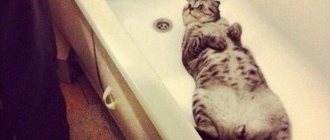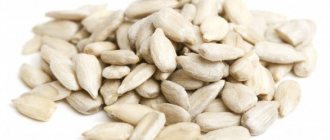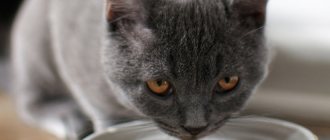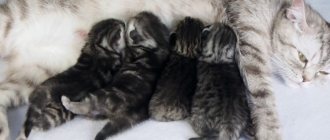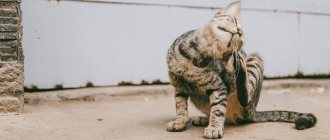Reasons for the habit
A deviation in pet behavior in which a cat sucks or licks clothes, blankets, carpets, its own fur or the tail of another animal is called “sucking syndrome.”
Veterinarians identify the following factors influencing the appearance of the habit:
- The kitten was weaned from its mother before 8 weeks. The problem arises due to lack of care and concern on the part of the cat.
- Various diseases. These include brain tumors, diabetes mellitus, anemia, lack of vitamins and minerals, leukemia, and immunodeficiency virus.
- Stress suffered by animals. Separation from the owner, moving to another apartment, the birth of a child, divorce, unsanitary conditions can lead to such deviations in behavior even in adults.
- Lack of attention. In this way, the pet tries to attract the attention of its owners.
- Sedentary lifestyle. The addiction occurs in cats that do not go outside. Due to lack of stimulation and physical activity, the cat becomes bored and thus seeks care and attention.
- Breed. Scientists have proven that cats of oriental origin are prone to bad habits.
Why does a cat need to hide?
Some cats prefer to sleep next to their owner from childhood, and then it becomes a habit for them. A little kitten is scared and cold alone, but under the blanket it is cozy and pleasant. Many pets like to sleep with a blanket on top, leaving only their nose and ears outside. They consider this quite convenient, because the owner also sleeps like this. You can also put your head on the pillow.
© shutterstock
If the cat does not have his own house, then you should not ask why he chooses a bed or sofa. The need to find a safe hiding place can arise in a cat for various reasons.
The cat crawls under the blanket because:
- sick and looking for warmth;
- awaits the appearance of offspring;
- loves comfortable rest;
- wants to smell the owner;
- marks its territory;
- rarely sees the mistress of the house;
- wants to be safe.
Since a cat's body temperature is slightly higher than a person's, it is more acceptable for her to sleep in a warm place, for example, under a woolen blanket or rug. The blanket itself cannot provide warmth, but it effectively reduces heat loss and helps the animal maintain a constant body temperature.
Pregnant cats look for a secluded, quiet place. They understand that kittens also need warmth, so they choose a comfortable place.
Another important reason is the desire to feel comfortable. The bed and blanket are soft and pleasant. Every second cat usually prefers a hard surface to a soft one. It is much more comfortable for a small kitten to sleep on a soft one; it reminds him of his mother, the company of brothers and sisters with whom he grew up. Elderly cats may be bothered by joint pain, which subsides a little in a warm place. It is much more comfortable for them to lie on a soft bed.
All living creatures strive for peace, and reliable shelter allows them not just to doze off, but to fall asleep deeply. It is the deep sleep phase that allows you to truly restore the strength lost during the day. It is during this period that the animals’ immunity works in full force, the processes of cell division in the body are activated, and tissue renewal occurs. So you shouldn’t be surprised that the cat tries to crawl under the covers or blankets on its own. This behavior of a pet is quite understandable and understandable.
Sometimes you can notice that the cat is moving its paws over the blanket.
This could be due to several reasons:
- the animal shows that it feels good and pleasant at the moment;
- a childish reflex appears when, as a kitten, a cat kneaded its mother’s belly to get milk;
- In this way, the pet marks its territory, because on the pads of the cat’s paws there are glands that secrete secretions.
Scientists have found that constant stress and the inability to get enough sleep lead to premature aging of animals and various diseases.
Usually a cat hides in a dark place for its own safety. Life is filled with fears and stressful situations. Climbing into a closet with clothes or under a blanket, he feels the familiar smell of the owner and finds peace.
Not all animals can be alone for a long time and really don’t like it when the owner goes to work during the day and returns home late. Lack of communication and the need to be alone for a long time force cats to climb into those places that store a familiar smell.
© shutterstock
Pets can be attracted not only by affection for their owner, but also by the smell of their sweat. This is especially true for situations where the cat’s owner is a man. She may like the way his shaving cream or shower gel smells, especially if it has notes of mint or valerian.
For young animals, a blanket can act as an ambush during playtime. From under it, the cat can quietly stalk prey, and at an opportune moment suddenly attack and grab it.
Why is it dangerous?
If the pet then starts eating the owner's things, the risk of intestinal obstruction increases.
First of all, it is necessary to find out the reason for this behavior of the pet in order to exclude serious diseases. If the animal is healthy, then the worst thing is when the cat goes from sucking things to chewing and swallowing them. Which can lead to blockage of the esophagus and intestinal obstruction, and such conditions often result in death. If the fabric is synthetic or contains toxic dyes, the animal will develop severe intoxication.
Additional accessories
However, owners can take other actions. For example, you can place a scratching post next to the bed in the bedroom and gradually the cat can start sharpening its claws on it. Also:
- brush the animal regularly;
- trim your nails.
The now popular silicone claw caps are an attractive solution only at first glance.
Animals never stop sharpening their claws, so sooner or later the pads will tear, but this is not the worst option. Sometimes the pads come off along with the claws, and this is very painful. Return to list
How to wean it off?
In order for a cat to stop sucking a blanket, the very first thing you need to do is eliminate or reduce the number of objects around that can be used for sucking. No source, no problem. You can repel with a spray bottle of water or aromatic oils with citrus scents. Veterinarians also insist on conducting a full examination and identifying possible causative diseases or complications. If a deficiency of nutrients and vitamins is detected, the cat is prescribed a special diet.
It is important to distract the student from unwanted games. Especially important are those that will develop trust between the purr and the owner. When you see your pet doing an obscene activity, you need to distract him for at least 10-20 minutes so that the cat’s brain has time to switch. At the end of the game, you can pet the animal or offer it a treat. Then he will enjoy the entertainment, and not from sucking on the blanket. It is important to provide the child with toys that will not let him get bored during the day when the owners are at work.
Breeders remind you that care should be taken to have several scratching posts, high shelves or a whole complex. The tray and feeding area should be kept clean. Then the animal will feel comfortable and safe. You should never punish or beat someone for bad behavior or strange habits. On the contrary, you need to surround your pet with care, affection and attention, then he will not have the desire to attract attention to himself by sucking on the blanket.
Materials for blankets and bedspreads
The most common:
- satin or polysatin - natural, cotton or artificial, polyester fabric. Smooth front surface, matte back;
- The tapestry is distinguished by its textured surface and complex patterns. The creation of the pattern occurs during the process of making fabric using yarn of various colors. Sometimes whole stories are woven. The yarn contains cotton, wool, silk, polyester. The bedspreads are very expensive, but practical: they wash well and last a long time. It is all the more annoying to see that the cat uses the textured surface of the bedspread as a scratching post, the pattern is broken and the thing is damaged;
- Many people confuse jacquard and tapestry, because in both cases the design is not applied by printing, but during the production of the canvas. But there is a difference: jacquard has a satin weave, a denser and smoother texture, a minimal set of colors and patterned (not plot) patterns. Jacquard bedspreads are very beautiful, but claw marks ruin them;
- microfiber is a fleecy fabric of artificial origin, very soft and pleasant to the touch. The pulled out fibers are not so noticeable on it;
- percale - thin, dense, smooth fabric;
- artificial leather and suede. The velvety texture of the materials is very attractive to pets, but claw marks are less noticeable on suede;
- velor and flock have pleasant, moderately fleecy textures. They are ideal for bedspreads in a house where there is a cat - they look beautiful and expensive and the pulls are invisible;
- fleece (coral fleece, velsoft) and faux fur - soft, fleecy textures. Velsoft can be washed in a washing machine, but fur is dry clean only.
Let's summarize. To make bedspreads for a bed or blankets for a sofa in a house where there are cats and small dogs, fleecy textures are ideal; claw marks will be visible on smooth and textured surfaces.
But you need to understand that the more fluffy the blanket, the more animal hair it traps. So it turns out that the ideal materials are artificial suede, velor and flock.
And one more proof - go to furniture showrooms and ask to show you the range of upholstery fabrics that are recommended for homes with pets. You will see that these are fabrics of a similar texture.
And don’t forget that there should be no decorations like tassels on the bedspreads: animals love to play with them and end up tearing them off.
How to get rid of this behavior?
Firstly, the cat may outgrow this habit over time. The following methods also help. Gently press the cat’s nose and say “No” immediately at the moment of this behavior. You can also spray it with water from a spray bottle. However, for this to be effective, do these manipulations only when your pet is eating things, and not when you discover it, since the cat will not understand why you are punishing it.
Additionally, it is important that your cat does not have access to what she likes to chew or lick when you are not there to stop her. Store clothes in drawers and closets that are out of reach of your cat. Some people whose cats lick and chew their hair at night sleep with hats on! My four month old cat also loves to play, lick and eat her hair down, so I wear her hair in a ponytail at home.
Some people try putting hot sauce or something non-toxic but bad tasting on things that the cat likes to chew.
In some cases, giving your cat chew toys designed for dogs seems to help.
There is also a safe repellent spray for cats (as in the picture). It is sprayed onto the object that you want to protect from the cat's teeth. We tried this spray to prevent the cat from tearing at the leather chair, but, to tell the truth, it didn’t help much.
If this behavior is caused by stressful events in life, provide your cat with additional confidence by showing her attention, care and affection, and play with her more often.
If your cat lives exclusively indoors, enrich her living space and give her something to do. Make sure your pet gets enough daily physical activity. If possible, play with your cat several times a day. Make sure you have climbing and sitting devices, bird feeders outside the window, an aquarium, and interesting toys. Some cats may even enjoy a daily walk outside on a leash (in our climate, though only in the summer).
Some cats eat fabric because they want to attract the attention of their beloved parents. It is important that you do not accidentally reward your cat with attention when she exhibits this behavior. If you reinforce this behavior, for example, by following her around so that she doesn’t eat anything, petting her, picking her up, then she will only reinforce this negative behavior. It is best to interrupt this activity without interacting with the animal. Simply pick up the thing she's chewing or clap your hands to distract her from the activity.
Why does a cat suck a blanket, blanket, tail or paw?
Owners don’t think about how to wean a cat from sucking a blanket if every morning the pet has a happy face:
This behavior is a sign of trust and love between the pet and its owner. Sucking on a blanket saturated with the scent of a person of the highest rank in the family is a recognition of strength and, at the same time, one’s own safety.
If the cat sucks on blankets and other bedding not in the morning, there are several reasons:
- Impaired metabolism.
- Stressful situation (sucking calms).
- The kitten is teething.
- The sucking reflex has not faded in a baby or an already mature cat.
Sucking a tail or paw should alert the owner: perhaps the cat is trying to pull out a splinter. If, when you carefully feel the paw, the cat withdraws the limb, you will need the help of a veterinarian. If no pain is observed, he may have been taken away from his mother early or he is experiencing severe stress.
How can I stop my cat from constantly licking?
To stop your cat from constantly licking:
- Stop them from continuing this behavior.
- Start by removing any intangible items from your home that they frequently lick.
- If you cannot remove the items, spray them with a special pet spray, which should have a bitter taste and discourage your cat from continuing to lick.
To occupy their licking time, try providing safer alternatives such as non-toxic pet toys and spend time cuddling with them instead. If you distract your cat during times when she is most likely to want to lick, you can encourage her to stop this bad behavior.
Source
Why does a cat lick obsessively?
Cats who obsessively lick may be suffering from either boredom or a compulsive disorder. Often, compulsive licking of cats is a sign of persistent mental imbalance. Cats may also suffer from anxiety or other mental health problems.
If your cat seems to be a compulsive licker, spend time trying to redirect her attention away from licking herself and toward other playful activities.
Compulsive licking is more common in cats that live primarily indoors, as their surroundings are often less stimulating than cats that have free rein to explore their environment.
Another incident that can cause your cat to start licking is a big change in your home environment. If you recently brought home a new baby or a new pet, this may cause your cat to have a compulsive fit.
What does a cat mean?
A cat kneads, a cat massages—you can call it whatever you want. Everything refers to the same thing. Now the question is why people compare kneading to baking or massaging.
The cat rhythmically alternates its paws, pushing in and out against a soft, furry surface or your lap. This motion will remind you of a baker making cookies. This is why people associate kneading with massage or baking.
Why do cats wrinkle blankets? People believe that cats knead when they are happy and feel safe. There are many more reasons, which I will discuss in the following sections.
© shutterstock
